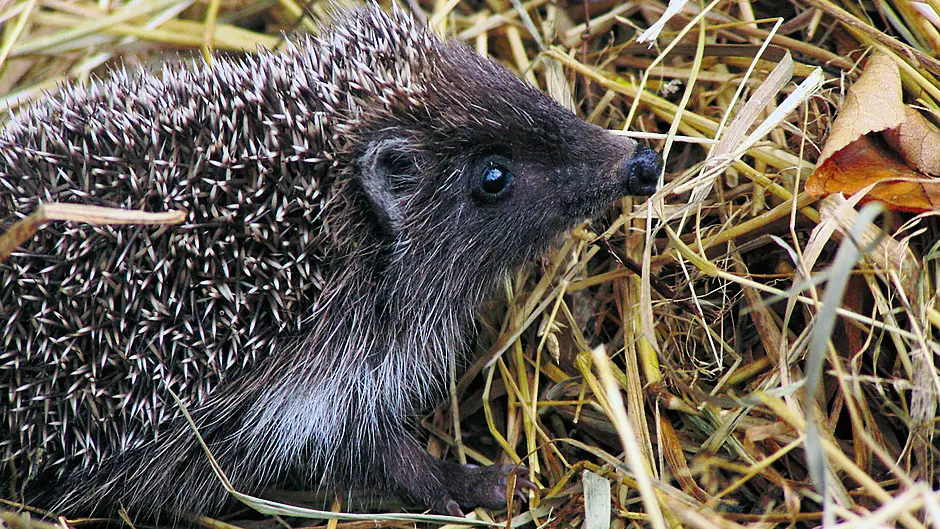THIS is the time of year for clearing out neglected areas in the garden and planting for the new season. But do be careful while doing so as you may disturb a very useful guest.
Hedgehogs survive the winter by hibernating in nests of leaves and grass, carefully built under the shelter of hedges, bushes or even garden sheds and compost bins. These small mammals are the gardener’s friend as they eat slugs and caterpillars, so we really want them around. They are starting to come out of hibernation now but are extremely vulnerable with their winter resources depleted.
Super spiney
Everyone knows what a hedgehog looks like but few of us have actually seen a live one. This tiny nocturnal creature has very distinctive features and cannot be mistaken for any other animal. Its coat of spines and small face makes it instantly recognisable.
An adult hedgehog has between 5,000-7,000 of these hard spines on its back which shield it from most predators. Extremely sharp, these spines are, weight for weight, one of the strongest known structural materials on earth.
A hedgehog’s spines are also flexible and act as shock-absorbers if the animal falls from a height. Each spine (actually a modified hair), is capable of moving individually via a muscle at its base, and can be raised in defence. However, when it feels threatened, the animal generally just rolls itself into a tight spiny ball which deters most predators.
The hedgehog can shuffle along surprisingly quickly on its somewhat stumpy legs, snorting and snuffling along the way. If startled, it will emit pig-like grunts and squeals – hence the name ‘hedgehog’. So quite often, you will hear this animal before you’ll get a glimpse of it under moonlight.
As a nocturnal hunter, the hedgehog’s sense of smell is excellent, as is its hearing, but it has very poor eyesight. In daytime it sleeps in a secluded, sheltered spot. So if you see this animal out and about during in sunshine, it’s probably in trouble.
A hedgehog is an excellent climber, with an ability to scale walls and banks, and is also quite a good swimmer. However, it can fall victim to garden ponds with steep sides or overhanging edges, so a plank of wood placed across the water will mitigate that danger.
Hedgehogs are known for their fleas but these are host-specific creatures and so there is little danger of them moving onto another animal. The hedgehog’s skin, along with its thousands of spines, is such a difficult place to live that only one species (the hedgehog flea) manages to survive there.
Strange tales
There are many strange tales and pishógs associated with this small animal. One says that a hedgehog will suck milk from a cow’s udder while she is lying down, especially on May Eve. This bizarre belief is easy to disprove as the small mouth of a hedgehog simply couldn’t grasp a cow’s udder, and surely a cow would have something to say about it even if it tried. Milk also upsets the digestive system of a hedgehog so it would not be a favoured foodstuff. Unfortunately this misconception resulted in this unfortunate animal being persecuted and killed for generations.
Another strange tale depicts a hedgehog rolling on an apple and impaling it on its spines to carry it off as a foodstuff. This features frequently in children’s stories and was illustrated in a thirteenth century English manuscript. However, hedgehogs don’t store fruit so the origins of this fable is yet another mystery.
There are many other bizarre superstitions involving hedgehogs, with quite a lot of them recommending the ingestion of this small creature as a cure for a variety of ailments ranging from lunacy to blindness. Fortunately all of these customs are now defunct.
The humble hedgehog is one of the most ancient types of mammal still alive today. Hedgehogs evolved over 15 million years ago and have survived, essentially unchanged, through ice-ages, geological changes and the evolution of man.
Hedgehog numbers in Ireland probably fluctuate on a cyclical basis as hibernating animals vulnerable to hard cold winters. However, in reality, we know little about how many hedgehogs there are in Ireland. An ongoing survey is seeking to remedy this situation, and it’s asking citizen scientists to help by reporting hedgehog sightings on the website irishhedgehogsurvey.com.








